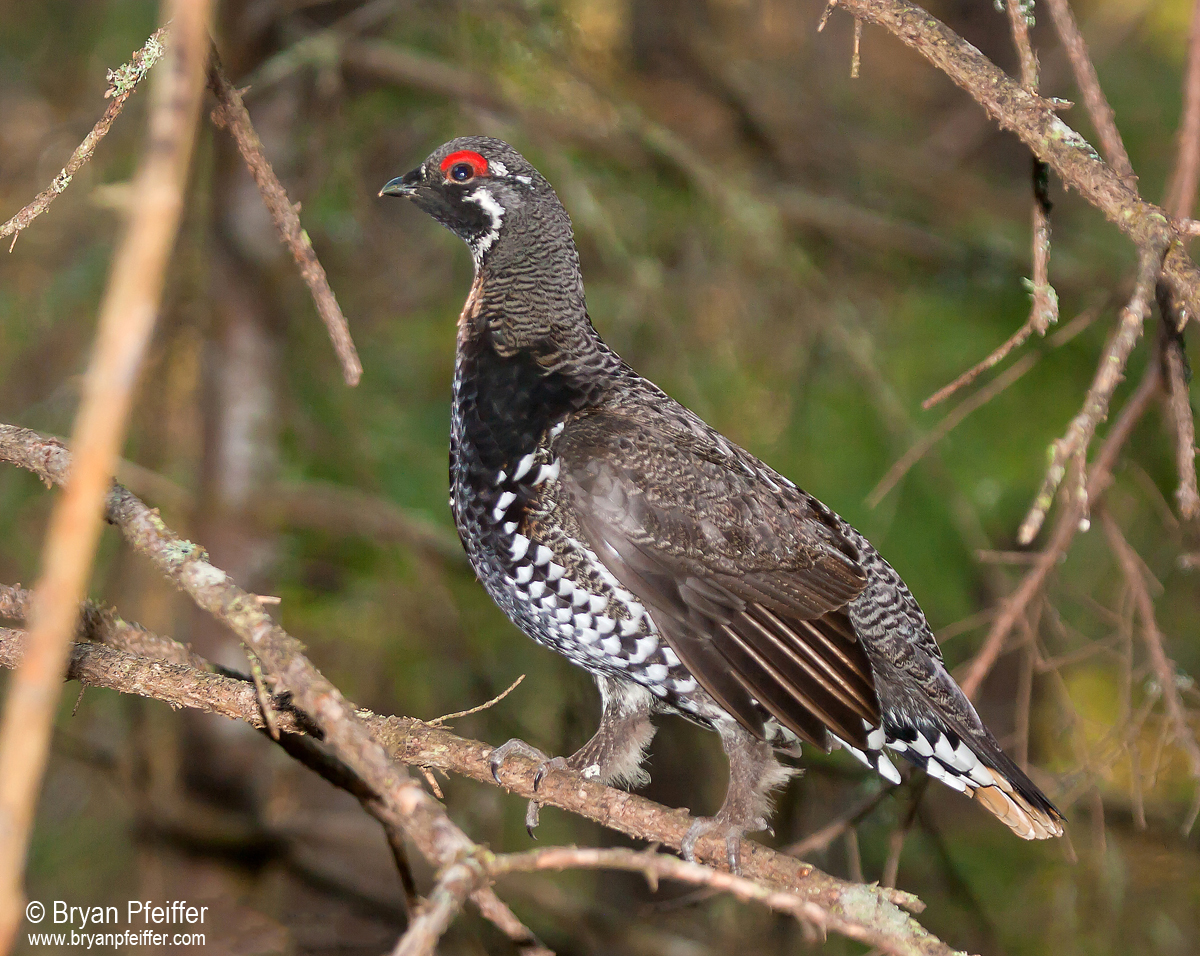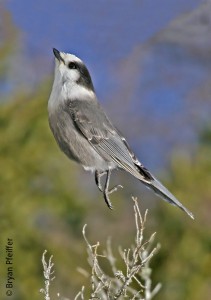Birding Vermont’s Moose Bog
Adapted from Birdwatching in Vermont
by Ted Murin and Bryan Pfeiffer
University Press of New England
ISBN 978-1-58465-188-8
AT DAWN ON MOOSE BOG, Gray Jays float like ghosts through a dense forest of spruce and fir. Boreal Chickadees betray their hiding spots with a nasal “tsk-a-DAY.” A Black-backed Woodpecker pounds a tall, dead black spruce. And all the while, a Spruce Grouse, among the most outrageous and elusive birds in these woods, fans his tail and courts a female.
No birding life in Vermont is complete without a trip to Moose Bog. Here in these remote lowlands, if you are vigilant, quiet, and of all due humility, here you may find the winged children of Boreas, the Greek god of the north wind. A basin with granite bedrock, this corner of the state lies at the southern edge of the boreal forest zone; it’s not really boreal but we call it that anyway. We also call this region the Northeast Kingdom. Among these remote forests are sphagnum bogs and spruce-fir-tamarack wetlands. Moose and black bear roam the woods. It is a delightful place, explored best on foot or by ski or snowshoe.
Much of the prime lowland boreal habitat is remote and inaccessible for all but the insect-tolerant bushwhacker. A notable exception is Moose Bog in the state’s Wenlock Wildlife Management Area. Here an observant non-bushwhacker can locate the boreal grand slam: Spruce Grouse (rare), Black-backed Woodpecker (rare), Gray Jay (uncommon), and Boreal Chickadee (sparse but fairly common). (Keep in mind that playing a recorded bird song to attract an endangered or threatened species such as Spruce Grouse can be construed as harassment and, as such, is illegal in Vermont.) All these birds are here; so your relaxed, patient exploration is the best approach for finding them.
Directions: From the old railroad depot in Island Pond, which is a village in the town of Brighton, drive Route 105 east for 9.4 miles and turn right onto the unpaved South America Pond Road. Pass through a metal gate and park in a small pull-off ahead on the right. This road is unplowed in winter, but a cautious driver can sometimes find a spot along Route 105 about one-quarter mile east of South America Pond Road. From this parking lot it is not even 0.25 mile to the western end of the Moose Bog trail.
In spring, which here is in late May, the excitement begins with the first step away from the car, where a Gray Jay might greet a lucky visitor. Walk the road toward an open wetland a few tenths of a mile from the parking area. Nashville Warbler, Magnolia Warbler, and Yellow-rumped Warbler are common nesting species. Shy Boreal Chickadees sometimes join the more inquisitive Black-capped Chickadees. And Gray Jays sometimes float over the road. At the wetland look carefully for Black-backed Woodpecker, which has nested here.
While walking to the wetland, notice on the right (west) side of the road large boulders blocking a path through the woods. This is the Moose Bog trail – three-quarters of a mile of delightful walking and birding. Dense with conifers, this trail passes through good habitat for Spruce Grouse (especially near the start and end of the trail), Gray Jay, and Boreal Chickadee, in addition to the aforementioned warblers. Ruffed Grouse lives here as well. Cape May Warbler and Bay-breasted Warbler make appearances here on occasion in late May. Both kinglet species nest here, as does Yellow-bellied Flycatcher. The nomadic and sporadic White-winged Crossbill can be abundant and nests here from winter to spring during heavy cone years. One winter an American Three-toed Woodpecker paid a visit.
Approximately two-thirds of a mile down the trail from South America Pond Road (past a small stand of white cedar on the right) are a few well-worn (and not-so-well-worn) paths on the left leading to the bog. Not very far beyond the paths, a large boulder blocks the other end of the trail near Route 105. Missing the paths to the bog might not be a bad idea, however, since Spruce Grouse can be found toward the main trail’s terminus.
Moose Bog, only a few hundred feet from the main trail, is a classic black spruce woodland bog — a dreamy place at dawn. At the opening’s edge is a floating mat of sphagnum and classic bog plants, including Labrador tea, bog rosemary, pitcher plant, and sundew. Please remain near the bog’s forested edge and expect wet feet. Look for Common Raven overhead and Boreal Chickadee in the woods around the bog. Black-backed Woodpecker and Gray Jay can sometimes be found in the woods here or among the bog’s scattered black spruce and snags. Cedar Waxwing loves it here, and Lincoln’s Sparrow belts out its bubbly song.
Although Moose Bog is a quintessential Vermont birding destination, it certainly not the only stop in this region. In fact, if you want to pad your warbler list, you won’t do it here. Hardwood warbler species, including Ovenbird, Black-and-white Warbler, American Restart, Black-throated Blue Warbler, and others aren’t typically found along the Moose Bog trail. So spend some time birding the many miles of dirt roads in this region. You’ll probably bump into Mourning Warbler, Canada Warbler and other uncommon northerners.
One option is the many spectacular stops in the nearby Silvio O. Conte National Fish and Wildlife Refuge (Nulhegan Basin Division). Another is West Mountain Wildlife Management Area. Spend a lifetime in either location and you will not discover half their secrets.




Every visit to Moose Bog is different. I arrived late afternoon. No Boreal species. No Black flies which was a plus! While peacefully sitting at the wooden platform I saw the eastern Kingbird, Kingfisher, Northern Flicker, Black-Capped Chickadee, and Cedar Waxwing.
Spruce Hen were also so called because they are almost as tame as a chicken, and the hunger woodsmen could just walk up and club them for a tasty meal. Back in the late 50’s my Dad and some friends leased a remote fishing camp in Maine just west of the Rangeley Lakes. We would almost always see a Fools Hen on the trail into Camp, but the rule was strictly look but don’t touch.
Love Moose Bog, there is something very special about that place. I’ve hiked it many times, and for awhile when I was a naturalist I led small groups from the state park out to the Bog. I am surprised to read that Spruce Grouse are elusive? I’m not a birder, but nearly every time I hike out there I see them, and they are not afraid of people at all. I’ve had them come right up to me and peck at my feet. I think (if I remember correctly) they earned the nickname “fool’s hen” because they are so fearless around people. In addition to birds, there are some really interesting plants in that area, including carnivorous sundews and pitcher plants and edible cranberries. Lots of bear activity too. Anyway thank you for a good read, Moose Bog is a gorgeous and magical place and holds a special place in my heart.
Thanks, Leila. Yep, “Fool’s Hen” also because some folks walk beneath and never see them. 🙂 I know a good birder who’s been up there many times and not seen Spruce Grouse. But how I would love to have a Spruce Grouse peck at my feet!
Well, darn, now I wish I had taken some photos. I guess I didn’t realize how special these encounters were. Maybe it’s the time of day? Not being a birder, I usually ended up out that way mid-day. I know a lot of birders go out early in the morning, I have no idea if that is a factor? Really, spruce grouse were always one of the most common things we would come across out there. Seems like they’re always sitting in trees, right at about eye level. The other thing, this was probably ten years ago now. Maybe the population numbers have changed and they are scarcer than they used to be. Anyway, thanks for letting me know, I have a new appreciation for the encounters I’ve had with spruce grouse. 🙂
Thanks for that beautiful description, Bryan! Such a wonderful place, ‘though I’ve only been there in the winter. We’re headed up north this week and I’m planning to check out Pondicherry Wildlife Sanctuary in NH, a somewhat similar place, I think. Maybe I’ll see black-backed woodpecker. Maybe I’ll get really luck and see cape may or bay-breasted warblers. Better go study my bird calls . . .
Hi Ann, Pondicherry is spectacular. The boreal birds, as I recall, might be a bit easier to encounter. And, yeah, tune your ears to the high frequency for those warblers. Keep me posted!
Great description of a great place–even if I have been skunked by spruce grouse on 100% of my visits. I’ve often thought it would be great to have your book online, with the locations in google earth or some such thing. I couldn’t figure out how to make it pay off for you though. This is a nice start!
Thanks, Kyle. I’d say I see Spruce Grouse there on fewer than half my visits. I suspect I unwittingly walk past them on all my visits. But at least you’ve got something wonderful to look forward to!
Muir, Beston, Thoreau, Pfeiffer … even your more informative essays (thanks for this, I’m looking for a handful of places to visit in June) are written with the same cadence of the place(s) you write about. So enjoy your blog, Bryan. Thanks for sharing your gifts, talents and tutelage with us.
So very kind of you, Emily. And so many sacred places to discover here in Vermont. I’ll see you out there!